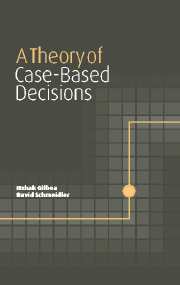2 - Decision rules
Published online by Cambridge University Press: 22 September 2009
Summary
Elementary formula and interpretations
Expected utility theory enjoys the status of an almost unrivaled paradigm for decision making in face of uncertainty. Relying on such sound foundations as the classical works of Ramsey (1931), de Finetti (1937), von-Neumann and Morgenstern (1944), and Savage (1954), the theory has formidable power and elegance, whether interpreted positively or normatively, for situations of given probabilities (“risk”) and unknown ones (“uncertainty”) alike.
While evidence has been accumulating that the theory is too restrictive (at least from a descriptive viewpoint), its various generalizations only attest to the strength and appeal of the expected utility paradigm. With few exceptions, all suggested alternatives retain the framework of the model, relaxing some of the more demanding axioms while adhering to the more basic ones. (See Machina 1987, Karni and Schmeidler 1991, Camerer and Weber 1992, and Harless and Camerer 1994 for extensive surveys.)
Yet it seems that in many situations of choice under uncertainty, the very language of expected utility models is inappropriate. For instance, states of the world are neither naturally given, nor can they be simply formulated. Furthermore, sometimes even a comprehensive list of all possible outcomes is not readily available or easily imagined. The following examples illustrate these points.
- Type
- Chapter
- Information
- A Theory of Case-Based Decisions , pp. 29 - 61Publisher: Cambridge University PressPrint publication year: 2001



